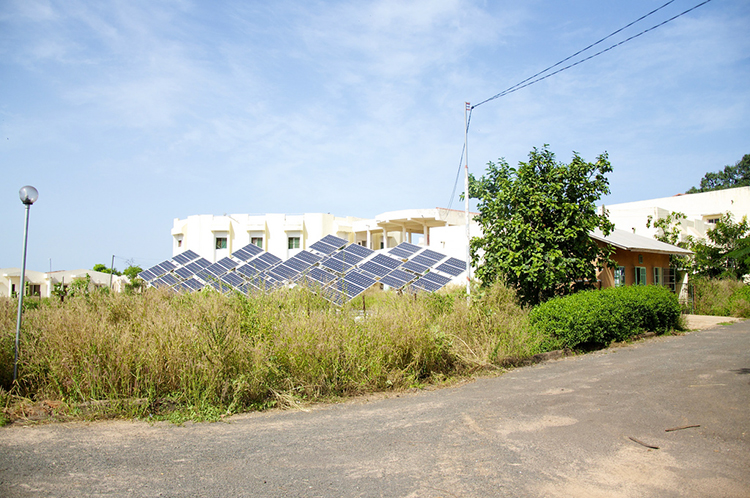West African countries have set ambitious goals to extend energy access to their entire territory, while 75% of the world’s unconnected households are located in Africa. But in areas far from the central network, where populations are often dispersed over great distances, , achieving electrification projects at acceptable costs remains an immense challenge. 530 million people on the continent are concerned. What technological choices should be made to improve access to electricity, and on the basis of what criteria? This was the subject of the webinar organized on Wednesday, May 19th by Think Smartgrids, in partnership with the French Energy Regulatory Commission and the network of French-speaking regulators RegulaE.Fr.

From individual electrification solutions to central grid extension, a diversity of solutions
The extension of national grids has long been the reference model for electrification in Sub-Saharan Africa. However, this long and costly process is not always the most appropriate in regions far from the central grid with low population densities. Development agencies, regulators and African governments are increasingly turning to microgrid solutions to ensure access to electricity in remote villages. Microgrids have the advantage of being able to be installed and commissioned quickly, at an increasingly affordable cost.
RegulaE.Fr, a network for the exchange of best practices and mutual cooperation between French-speaking regulators, is taking a close interest in the subject. This network aims on the one hand to meet the challenges of economic development through improved access to energy, and on the other hand to better disseminate the principles of energy regulation in French-speaking countries, as well as the technologies that will accompany their energy transition. Microgrids are a good example: developed in France, particularly in island territories, they can also provide concrete solutions to electrification needs in isolated African territories.
In Burkina Faso and Benin, several microgrid solutions are being studied, depending on the size of the population, their location and the distance from the main grid. Depending on these criteria, a connection to the main grid, individual electrification solutions or various mixed microgrid solutions can be set up: solar mini grid with gas generator, solar hybridization and diesel engine, or solar micro power plant and battery, with or without diesel engine. Each solution is studied according to its cost. Mariam Nikiema, president of the Burkina Faso regulatory authority, points out that it is still often difficult to do without a generator to provide a continuous supply of electricity.
To optimize decision-making between these different solutions, EDF R&D offers a technical tool, called LENI, to determine the best electrification strategy, with a combination of solutions articulated in time and space, depending on development objectives (political, social, economic, environmental), geography, changing electricity needs and population density. The tool combines digital mapping, algorithms for optimal design of electrification solutions, and artificial intelligence for pattern recognition and demand estimation. Solutions can range from individual solar systems, such as rooftop solar panels, for very low population densities, to microgrids and extension of the central grid for the nearest villages. Bruno Prestat, Director of International Affairs at EDF R&D, adds that it is possible to combine these solutions, with a very gradual extension of the grid.
Microgrid projects are on the rise
In order to combine different technological solutions, Sagemcom is developing a global electrification solution for off-grid rural areas. The equipment manufacturer started from the observation that when a microgrid was implemented, a large part of the target population, too dispersed, remained unconnected at the end of the project. According to Yann Chauvelin, director of rural electrification development at Sagemcom, this was due to the plurality and incompatibility of the technological solutions used to adapt to the different use cases. Sagemcom has therefore developed a technological solution allowing the operator to combine several technologies (mini-grid, individual electrification solutions…) on the same project, in order to meet the different technical constraints and to supply a larger part of the population, while optimizing maintenance costs. The Siconia Power Grid software suite, a unified Smart Grid platform, combines multi-energy smart metering, mini grid solution, distribution network supervision and pricing.
As part of the Poles2020 energy transition program of Senelec, the Senegalese utility, Omexom has set up 7 hybrid solar-diesel power plants for the electrification of the Dakar suburbs and the development of a microgrid on the Saloum Islands. This energy solutions integrator carried out the whole project, from design studies to technical assistance for operation and operator training. The autonomous power plants combine PV modules, inverters, diesel generators and storage batteries to provide continuous access to electricity for local populations, who until now have been supplied only 6 hours a day, while reducing fuel consumption.
One of the major challenges of the microgrids developed is indeed to minimize the use of carbon sources while guaranteeing the reliability and durability of the proposed solutions. This is the ambition of Schneider Electric, which offers a wide range of solutions for electrification in rural areas, from mini solar panels to recharge a cell phone or to connect to the main grid, to minigrids and solar panels for domestic consumption. For François Borghese, Microgrid Marketing Director at Schneider Electric, an independent microgrid requires pooling and optimizing resources, planning the right size and scalability of the solution to ensure its sustainability, but also a remote control and diagnostic solution for optimal operation, with the corollary of taking into account cyber security aspects. Schneider has deployed several projects in Nigeria and Senegal combining solar, batteries and diesel generators, with the long-term ambition of developing solutions based 100% on renewable energy.
Financing microgrids remains a challenge.
Another crucial issue is the financing of off-grid electrification projects. The French Development Agency (AFD), which finances many energy transition projects around the world, has historically supported mostly grid extension or intensification projects. However, efforts are increasingly focused on the development of mini-grids and solar kits, notably thanks to the drop in the cost of solar panels and batteries, as well as favorable technological developments, such as the development of remote control solutions, smartphones and pay-as-you-go solutions, which have made systems more reliable and more profitable. AFD supports policies that promote electrification, finances studies and electrification programs, as well as the development of innovative solutions.
The mini-grid and off-grid markets are developing rapidly, but Anne-Sophie Rakoutz, from AFD’s Energy Division, points out that financing has been concentrated on large players and East Africa. Moreover, investments are still considered risky for mini-grids, with high connection and operating costs, as well as a risk both on demand, which is sometimes below expectations, and on the ability of customers to pay, particularly individuals and small businesses. In the current health and economic context, AFD has observed a sharp decline in demand and a significant increase in non-payment, which is accompanied by a drop in private investment, as the market is still very dependent on donations and crowdfunding.
To create a more favorable context for the development of microgrids in West Africa, Anne Sophie Rakoutz stresses the importance of political leadership, a stable institutional and regulatory context, and planning that integrates the various electrification solutions in order to make the right trade-offs from the outset. Electrification must be thought of as an “integrated service”. There is also a strong need for studies to be carried out upstream of projects to design correctly sized and sustainable structures, as well as the necessary implementation of a mode of governance that integrates local specificities and communities. However, the question of the cost of projects and their maintenance remains the central issue, in order to guarantee an acceptable electricity tariff.
Webinar available on demand: https://app.livestorm.co/think-smartgrids/du-microgrid-a-lextension-du-reseau-central-quelle-solution-adopter?type=detailed
With the interventions of:
- Catherine EDWIGE, Commissioner at the French Energy Regulatory Commission (CRE) and President of RegulaE.Fr
- Anne-Sophie RAKOUTZ, Project Team Leader_Energy Division of the French Development Agency (AFD)
- Bruno PRESTAT, International Business Development Director, EDF R&D
- Yann CHAUVELIN, Director of Rural Electrification Business Development, Sagemcom
- François BORGHESE, Microgrid Marketing Director, Schneider electric
- Marc FISCHER, Market and development manager, Omexom
- Erik HOUNGNINOU, Off-Grid Electricity Expert, Benin Electricity Regulatory Authority (ARE)
- Mariam Gui NIKIEMA, President of the Energy Regulatory Authority (ARSE) of Burkina Faso
Moderation: Thomas BAZIN, Strategic Account Executive, Schneider Electric, Chairman of the International Commission of Think Smartgrids, and Valérie-Anne Lencznar, Managing Director of Think Smartgrids.

